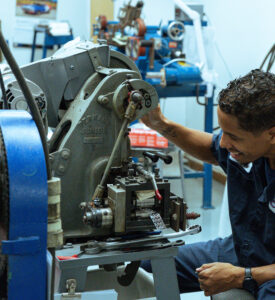At Clad Metal Specialties, we can clad virtually any ferrous to nonferrous metal. We combine ferrous and non-ferrous metals which allows you to utilize the essential characteristics and properties of the dissimilar metal(s) to meet custom requirements, based on the subject application. In this article, we’ll distinguish the definitions, differences, and typical applications of ferrous and non-ferrous metals.
Read more about the benefits of clad metals.
What are Ferrous Metals?
A ferrous metal is a categorization of metals that primarily contains iron. Ferrous metals play a critical role in various applications/industries that require their exceptional mechanical properties, such as construction, machinery manufacturing, automotive, and more. These characteristics include high strength, durability, and the ability to withstand harsh temperature environments. Another important characteristic is the magnetic properties they offer due to the iron content.
Common examples of ferrous metals include alloy steel (Stainless), carbon steel, cast, and wrought iron. Due to the high carbon content, ferrous metals are susceptible to rust when exposed to moisture. Two exceptions to this rule include a) Wrought Iron due to its purity and b) Stainless Steel due to the presence of Chromium.
Application Examples:
- Steel: An iron-carbon alloy used in electrical equipment such as transformers and electrical motors due to its magnetic and corrosion resistance properties.
- Stainless Steel: Used in the production of storage tanks, valves, and pipes within the Energy and Gas industries due to their corrosion and high-heat resistance characteristics.
- Carbon Steel: Known for its high carbon content and resistance to abrasion, therefore creating a durable metal used in tool making and various machinery applications.
- Wrought Iron: Used in piping and engine bolts/hardware due to the corrosion and fatigue resistance characteristics, as well as having weldability qualities.
Read Suggestion: Benefits of Inlay Clad Metals
What are Non-Ferrous Metals?
Non-ferrous metals, on the other hand, do not contain a significant amount of iron. These metals are known for their lighter weight (density), malleability, and corrosion resistance. However, they are not magnetic. They are typically favored in applications where exposure to moisture and weight is a concern (except lead).
Common examples of non-ferrous metals include aluminum, copper, copper alloys (brass & bronze), Nickel Alloys, lead, Zinc, and precious metals such as Gold and Silver.
Application Examples:
- Aluminum: Used in everything from food cans to airplane parts due to its lightweight and machinability characteristics.
- Copper: This ductile and malleable material has high conductivity for electricity and heat; Used in electrical components and wiring, semiconductors.
- Lead: Radiation shielding in X-ray applications due to the high-density characteristics.
- Gold/Silver: Both are used in electrical contacts due to their essential characteristics of resistivity, conductivity, and resistance to corrosion. The determination of whether to use gold or silver is dependent upon the application and surrounding environment.
Read Suggestion: Benefits of Overlay Clad Metals

Comparing Ferrous and Non-Ferrous Metals
Below is a brief list of the key differences between ferrous and non-ferrous metals:
- Iron Content
- Resistance to Rust and Corrosion: Ferrous metals are prone to rust, except for stainless steel and wrought iron. Non-ferrous metals are generally more resistant to rust and corrosion.
- Magnetic Properties: Ferrous metals are typically magnetic, while non-ferrous metals are not.
- Weight & Density: Non-ferrous metals are lighter and less dense than ferrous metals.
- Strength & Durability: Non-ferrous and ferrous metals are strong and durable in their ways. Ferrous metals are more suitable for load-bearing applications whereas non-ferrous metals are well-suited for conductivity of heat and electricity.
- Recycling: Both types can be recycled, but non-ferrous metals retain properties through repeated recycling, unlike ferrous metals.
Clad Metal Specialties: Your Partner in Metal Selection
At Clad Metal Specialties, we provide more than just materials – we offer solutions. Our team, equipped with extensive industry knowledge, assists in offering the perfect metal combination for your projects, whether it involves inlay or overlay clads. Trust us to guide you through the complexities of metal selection, ensuring the success of your projects.
 Explore our full range of services and how we can contribute to your next project at Clad Metal Specialties.
Explore our full range of services and how we can contribute to your next project at Clad Metal Specialties.
